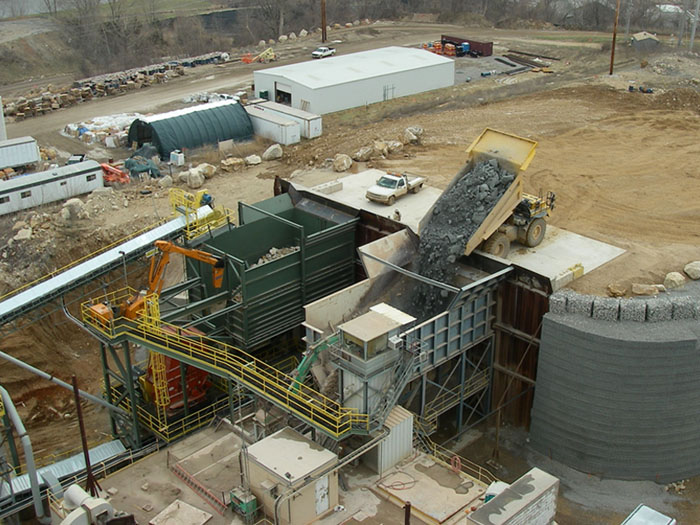Discrete Event Simulation of In-Mine Logistics
By Kwame Awuah-Offei
Debottlenecking loader/truck/crushing operations is a concern in most mineral ore processing facilities. Utilizing computer simulation using mathematical and logical relationships to replicate a real system is the best way to design or optimize an operation, prepare facility layouts and select mobile equipment. Discrete event simulation (DES) involves events (arrival, departure, etc.) that occur at discrete points in time. DES involves random processes -typically, some theoretical statistical distribution- which is handled using Monte Carlo simulation. There are various special purpose simulation languages, like GPSS, Simscript, SLAM and SIMAN for modeling discrete and mixed continuous-discrete event systems. At PEC Consulting we use Arena®, which is based on the SIMAN simulation language.
Figure 1. Loading Trucks in Mining Operations

DES applications are ideal for mining activities, material handling systems, and transportation systems. We use DES to study truck-shovel systems, underground haulage systems, mine-to-mill systems, and more. The models provide value to the engineering and management teams who commission the studies.
The main purpose of simulation and DES is to examine alternate scenarios (what-if analysis) on the computer, which is exponentially less expensive than the real system trial-and-error or experience. For example, the cost of using computer simulation to examine the effect of adding a dump truck to a mine’s haulage system is minimal compared to the real cost of adding a truck, even when the truck is leased. The choice is between analyzing the system with simple spreadsheets, other operations research techniques (e.g. queuing theory), or heuristics (experience based set of rules).
Figure 2. Transportation in Mining Operations

1. Main Advantages of DES
The main advantages of DES are the following:
- Flexibility to model various levels of detail and complexity.
- Allows modeling of uncertainty.
- Allows modeling of dynamic (time-changing) systems.
- Advances and variety in DES software (such as those mentioned above).
2. Main Disadvantages of DES
The main disadvantages of DES are the following:
- DES provides only approximations/estimates of your model outputs, which is nonetheless all that is possible in most complex systems.
- DES is heavily reliant on statistics, with which most engineers are not comfortable.
3. Main Motivations for Using DES
There are three main motivations for using DES:
- The system under study has significant variability in input variables.
- Enough data is available or can be collected to fully characterize the variability in key input variables.
- The risk of making the wrong decision outweighs the costs of the simulation study.
Figure 3. Trucks Transporting Material

In most mining operations, there are several causes of variability in input variables. For instance, cycle times, equipment reliability, and payloads are all variable in material handling systems. It is easy to assume that using the mean values of these varying inputs can provide a good estimate of system performance. While that estimate is good, such an analysis (which is what you get for spreadsheet-type analysis) does not account for the effects of the variability. If you are evaluating the effect of adding one more hauler to your system, for example, using the mean cycle times will provide an estimate of the expected increase in production. It does not answer questions like, how often (probability) will I achieve that increase due to the variability in the system? What will be the worst queue of haulers I will have at the shipping yard or loading point?
An important aspect of any simulation study is the input data. Enough data must be available to allow statistical goodness-of-fit tests to determine what distributions to use for various inputs. These days, though, with the advent of dispatching systems and various automation systems, data collection is much easier.
Figure 4. Truck Unloading Material

Simulation is not inexpensive. It requires time and resources to do a good job. A good team needs to be put together with various stakeholders, not just the analyst and engineers, to describe the system and help determine alternatives to be studied. Most often, the skills required to build a good simulation model are not found in-house and require hiring a consultant.
PEC Consulting Group has provided modeling services to cement, lime, and aggregates operations. In doing so, we have helped in providing a tool to analyze the ‘what if’ scenarios for our clients’ quarry operations.
About the Author(s)
Kwame Awuah-Offei, PhD
Dr. Kwame Awuah-Offei collaborates as a Senior Consultant in Mining. He has extensive experience in modeling, simulation, and optimization of mining systems. He has worked in surface gold mining and aggregates operations, mine engineering, and the development of mine plans. Dr. Awuah-Offei holds a PhD from Missouri University of Science and Technology and a BS from the Kwame Nkrumah University of Science and Technology in Ghana.
PEC Consulting Group LLC | PENTA Engineering Corporation | St. Louis, Missouri, USA
How can we help you? Get in touch with our team of experts.
